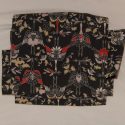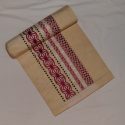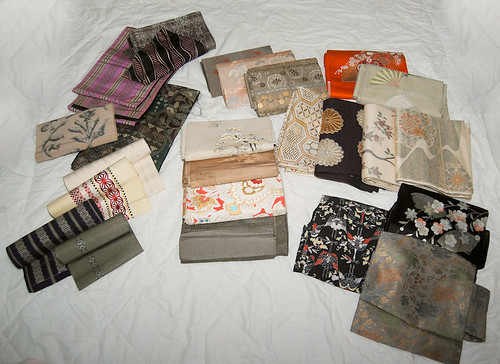Sorry for the lack of updates! Sometime between Christmas and Boxing day I received the heartwarming and thoughtful gift of gastroenteritis. I’m starting to feel better, but still don’t have a lot of energy for kitsuke. Since I’ve acquired a few new ones lately, I thought it would be a good time to discuss tsuke-obi, or pre-tied obi.
There are a few camps when it comes to tsuke-obi. Some people are staunchly against them in any situation, some people have to rely on them because they’re not confident enough yet, and some, like myself, think that well-made ones have their place in any decent kimono wardrobe. They’re a godsend when you’re not feeling well and don’t have the energy to deal with an obi, or if you need to dress a bunch of people in a hurry. They’re useful for fancy furisode musubi that would otherwise require two people to tie. They’re also great for dressing people who don’t have a lot of experience wearing kimono, since they don’t need to be tied as tightly as a “real” obi would be.
Some of them definitely look cheap and are obviously pre-tied. The brightly coloured polyester types with a large butterfly bow that often come with yukata sets are a prime example of these. Except in the direst of situations, I’d never recommend going out and getting one of those, because nothing says “I can’t be bothered!” more than one. Especially if worn with anything dressier than a yukata! However, there are definitely nicer examples. Often times they’re made with solid old obi that have been damaged, or were owned and loved by someone who may have gotten too old to tie her obi efficiently. Some of them are also mass-manufactured, but in a way as to look more like “real” obi. They come in several different musubi, or bows, such as otaiko, niijudaiko, and some larger and more elaborate ones for furisode. Often times, once these are tied on properly and an obiage and obijime added, it’s virtually impossible to tell they are pre-tied. I’ve got a few of them, and two of them are probably some of my favourite obi in my collection.
This is such a stunning piece. I found it on eBay right before the holidays and my folks encouraged me to go ahead and get it and it would be a gift from them. I’m so thrilled. I’ve mentioned my fondness for lobster motif before, and this is not my first lobster obi, but it felt different enough from the one I had that I felt fully justified in buying it.
Pente is an interesting and relatively uncommon technique – it’s a thin layer of paint daubed onto the surface of usually solid black silk. It was popular after WWII when there were a lot of damaged pieces floating about and people generally didn’t have huge budgets for fancy embroidery techniques or high-end dye methods. It was also used to re-work mofuku (funerary wear) into something more useful for everyday, stretching the wardrobe budget further. Unfortunately, due to the nature of most paint, it’s incredibly fragile. It sits on the surface of the garment rather than sinking in, and decades of tugging and pulling on the obi while it’s being tied leaves most vintage pente obi in states of disrepair, paint flaking off or peeling in huge chunks. Because of this I generally avoid anything pente, but because this was a tsuke-obi there was virtually no stress on the paint and it’s in flawless condition.
One of the other interesting and relatively unique things about this particular obi is the way it’s tied. Like most pre-tied obi, it’s in a standard otaiko musubi, but unlike more mass-market ones, it’s tied on a quirky, jaunty angle. This really helps make it look like a “real” obi, and definitely gives it a lot more personality than a perfectly level one.
Black and white hakata obi


I make no secret of my ridiculous love affair with all things hakata, but somehow I’d never managed to acquire a standard black and white weave. When I found this one I fully expected it to go for more than I was willing to spend, but I figured I’d throw out a bid and see what happened. Imagine my shock when nobody else bid! This is another variation of an easy obi, it’s not really pre-tied, just separated into a narrow waist bit and a wider bit to tie the actual drum with. It requires a bit more time and effort than a fully tied one, but also allows for more leeway in tying.
Cream tsuke-obi with navy, ruby, and silver foliage

This is the first tsuke-obi I purchased, and was really the one that made me a convert. It’s a heavy almost silk blend that almost feels like parchment or canvas. The majority of the vines and leaves are dyed, but the red and silver ones, and a small selection of the navy ones, are embroidered over top, which adds a depth you don’t usually see in mass-market pre-tied obi.
Red synthetic with black flocked irises

This one is a synthetic, washable faux-tsumugi in a bright fire-engine red. It also has the strangest inflatable obi-makura (obi-pillow) sewn into it. I bought it mainly because of the flocking, which I loved, but it’s become a mainstay for a quick hit of colour.



















 Bebe Taian
Bebe Taian CHOKO Blog
CHOKO Blog Gion Kobu
Gion Kobu
Pingback: Object: Obi - UTSA Institute Of Texan Cultures
Pingback: Object: Obi | Institute of Texan Cultures Collections Blog
I have a bit of a personal prejudice against tsuke-obi (I feel that a lot of the young folks use them as an excuse not to learn old-style musubi) but as a Heian buff, I remember that people used to fake things (like layers via fake collars and sleeve ends) even about 1,000 years ago, so I can’t really say that there’s no historical basis for “cheats”- technically, dounuki and festive linings during the Meiji era might qualify as “kitsuke cheats”.
I have difficulty getting tsukeobi to stay put, myself. They tend to “roam” after I put them on, since I can’t tie them tightly enough, which leads to exposed datejime when their migration starts. I sometimes compensate for this by exposing a whole lot of obiage, but that’s way more racy a look than I’m trying for. ^^;
It’s useful to have a few tsukeobi, though, for those running-out-the-door late times which (as far as I know) everyone has from time to time. Also, some tsuke-obi have just marvelous motifs- I have one here which I bought just for the motif- a Heian noblewoman wearing a purple junihitoe. That it’s pretied is entirely superfluous to my decision to buy it- to me, it’s FIRST an obi I like, and SECOND a pretied obi.
I hope my comment makes a bit of sense. @_@
Ah! Since I’m commenting anyway- my weird sense of humor demands that I ask, have you ever worn the ROBSTER!obi to a seafood restaurant?
Kimono*Suki recently posted..Tutorial- DIY Date-Eri
I do agree that it’s sad when people use them solely to avoid learning how to tie at least a basic nijuudaiko or otaiko, but I still think they’re handy overall.
Have you tried tying the belt a little looser, and putting in a bit of extra padding underneath to smooth it out? It might not migrate as much if it’s got a more cylindrical shape to it.
I have not ever worn robster out to dinner, but I should at some point XD
I am only opposed to tsuke obi if people use them as a crutch against learning how to tie any musubi. I ran up against this all the time in Japan — I would say I was learning to tie otaiko, and people would say, “They make pre-tied obi, why not just buy one of those?” These tended to be salespeople or ladies who only wore kimono once in a blue moon. I think learning to tie the musubi is an important part not only of the craft, but also in self-expression. I may mostly use a pretty traditionally-shaped otaiko musubi myself, but I use a variety of hanhaba musubi. What you and Zuihitsu mention above is an excellent point, too — some bodies may not conform well to pre-tied stuff.
I *love* my tsuke-obi; I have three of them now, and while they’re all pretty blah colors (black, cream), they are SO handy when I need to wear and obi and have had obi fail all morning. Like at bonenkai this year – I had a cute holiday obi planned and couldn’t for the life of me get it to tie properly. Gave up, grabbed the black tsuke, and was out the door in 5 minutes.
(Though I have found that because they’re tacked into taiko shape, if I don’t pad my back end, I wind up with an odd duck-tail sort of thing happening when I least expect it. Oops!)
Haha, I do get a bit of that duck-tail issue as well since I can’t change the proportions of the otaiko. I just stick a little facecloth in the small of my back, over my juban, and it sorts it right out.